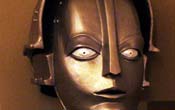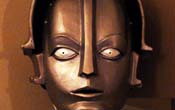The Metropolis Robot 'Maria' project
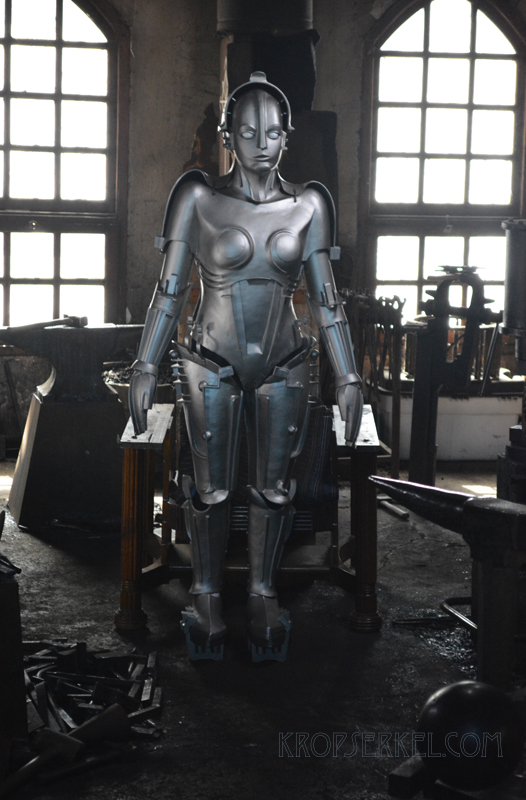
Kropserkel Inc. (Canada) and WSM Art Management (Germany) proudly present the official 2014 reincarnation of the world's most iconic symbol of science fiction in the history of film. This nameless robot is the 'Maschinenmensch' [human machine] or, the 'False Maria', 'Hel', 'Futura', 'Parody', and others.
With our interests deeply rooted in science fiction, armour, and the meaning of life, the opportunity to recreate the 1927 Maschinenmensch figure, and bring understanding onto all that it represents, has been a zenith level project for us. We felt that it was important to document some of the insights that were revealed to us throughout this incredible opportunity and endeavour. We hope to shed some light onto this enduring character whose true connotations are yet to be realized.
Interact with us and see development images on our dedicated Metropolis Robot Facebook page.
Rise of the Robot Maria : 'Der Phönix' from Scott Maple aka Kropserkel on Vimeo.
The Purpose
Few non-living film icons that exist in popular culture have remained elusive for examination beyond the images they left behind in film. An official and faithful likeness of the Robot Maria is perhaps the oldest and rarest of such things. The deep symbolism of the amalgamation of man and machine, and the prophetic foresight of its meaning from a different era is undeniable. A real world and tangible object is more to marvel at and ponder over. It gives us glimpses at wonders in design from the dimensional film artists that we would never have access to otherwise. As history on production records, the original prop was presumably consumed by fire in 1926 on set, and lost forever, with her only original images imprinted in copies of the film Metropolis, and a small smattering of production stills.
We wanted to bring her back in as faithful and respectful a manner as we could, and under the close guidance of the original creator's family, we have done so. Museum collections and high end collectors will finally be able to own reproductions of the Robot Maria to display, and to be appreciated by their audiences and friends in person. We also intend to produce artistic renderings of the figure for acquisition by a larger audience, and allow them to own official merchandise celebrating the creation of this character and its relevant meaning to us today, in the world of techno dependence, and human evolution by artificial means.
Interested? Please write to us at info@Kropserkel.com and join us on our dedicated
Metropolis Robot Facebook page.
Merchandise in development is listed on our PRODUCT page here.
The Video Production: Context to a Reveal
There are so many human sensory elements to consider when setting out to make a profound and memorable impression. Images and sounds can be crafted and controlled in a manner that keeps context for characters known only on the celluloid. The original robot itself could look fake if it was seen in the wrong environment and context. Even colour in this case was bound to work against us, being that it was only ever seen in black and white. We knew that the re-introduction of the Robot Maria to a new world would have to be something truly special in order to be accepted. It would have to be something other than a reproduction. We had long toyed with the idea of holding a live event to show her to naked eyes, wherein a small theatrical presentation with modern production values would play out in grand fashion to a live and intimate audience. Special modern lighting effects and holographic projection techniques would make for a spectacular reveal event. Our efforts were not to be realized in the short term, and never giving up, we turned to the new media in order to create something that could be enjoyed by many more people than a small venue could.
On a cold Canadian winter day in 2014, we set out to a magical location that would serve as our set. We shot segments with many location specific practical effects that lent themselves beautifully to our segment. The sunlight poured into smoky atmospheric rooms in the early morning, something this long Canadian winter had infrequently afforded us, and the fridgid stone floors kept us working at a warm pace. Everything environmental was cooperating. In that small Amish farming community of Floradale, we were making magic, and we all knew it. This robot had not been directed on film since it burned at the stake, and hosed down with extinguishing water back on a cold winter day in Berlin's Studio Babelsberg back in 1926.
The Construction Process: Assets to a Resurrection
Instead of having to start on this project as a reverse engineering process, we were privileged to be working under the direct guidance of the Schulze-Mittendorff family throughout. This gave us unique access to rare information and production stills that provided invaluable and personal accounts of the techniques that Walter Schulze-Mittendorff used in 1925-26.
We recognized that this undertaking would be a memorable experience for us, and were prepared to spare no expense in bringing it to fruition as such. We became bewitched by the original form, and its potent power to provoke introspection. Never before has an official replica of this costume been created. With the information we had amassed, we wanted our Maschinenmensch to reveal the many stories that we had learned in her recreation. We would commence on the endeavour back in 2008, giving attention to it as we could throughout the years up until 2014, when it would once again rise for the cameras.
Our Replica Brigitte Helm
German actress, Brigitte Helm (1908-1996), was just 19 years old when she played the duel roles of 'Maria', and the 'false Maria robot' in Metropolis. At the control of director Fritz Lang, she would also be the one to wear the Maschinenmensch costume in the film. She spent a rigorous and painful 9 days doing so in a frigid Berlin winter in January 1926.
As the basis for Schulze-Mittendorff's robot sculpture, a plaster cast of Helm's body was created from a mould taken of her while she was in a standing position so that her form wouldn't be distorted. Her rigid body casting would be required in order to fashion the fitted armoured parts. Finding a versatile model to play this role for our recreation was an important task, and it wouldn't be long before a friend would introduce us to a suitable candidate. An anonymous Canadian actress and stunt woman was the consummate choice for the basis of our Robot Maria costume. As a stuntwoman, she provided an athletic build suitable for the basis our sculpture. As an actress, she could mimic those unmistakable movements of the original figure, and could still have the endurance to be able to perform with the restrictions of a full body armoured costume.
Capturing the Likeness of Synthetic Nobility
By far the most challenging and important part of our sculpture is the recreation of the facial expression. If we failed to hit this mark, nothing else would matter. Depicted in our early first generation castings below, we were on the path to bringing this iconic being back into existence for the 21st century.
"I Dream in colour"
Colouration
The original robot, only ever seen in black and white, would need to be reborn into a world of colour. Working directly with Schulze-Mittendorff's family allowed us to derive the original colouration details through understanding the period descriptions he had written about, and the techniques used in that era. Schulze-Mittendorff's notes indicated that a cello lacquer was used as a medium, mixed with "Silberbronze" (an alloy of copper and silver) and shot through a spray gun for a uniform coating. A polished " Weißmetall" (white metal alloy) appearance had been achieved that was very convincing, even on close inspection. The cello lacquer would have provided a glossy finish which would have offset the granular aspects of the basis material, and being relatively clear, it would only show an amber tint after multiple coats. The Silberbronze would have been in fine powder form purely as a pigment, and would have required the lacquer in order to adhere. The mixture of pigments was described as silver, a white metal, and copper, a red/gold, and given that this was the mixture, we can derive that the finish must have been between these two metal hues, bringing us to an approximation of the middle finish below, a 'warm' white metal.
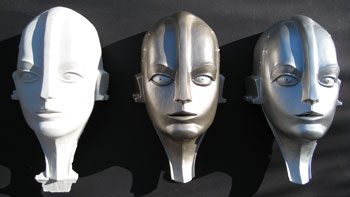
While the costume featured a uniform finish on all of its visible surfaces, photographic reference showed that the eye area appeared to receive additional colouration enhancement. The sclera (the white outer layer of the eyeball) was seen to be a striking gloss white, and the raised irises featured an extremely light metallic pigmentation, almost undetectable that separated them from the sclera. The eye lids appeared painted dark grey to further contrast the whites of the eyes just like eye liner make-up. These details brought out a necessary contrast to this region on camera and under the studio lighting, drawing your attention here. This characterized the described 'calm madness' expression that the script called for. Schulze-Mittendorff clearly had an excellent understanding of the importance of feeling as read through the eyes in his many works. In the silent film era, the eyes had to speak, and this was understandibly an amazing achievement for a static mask to convey.
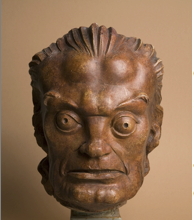
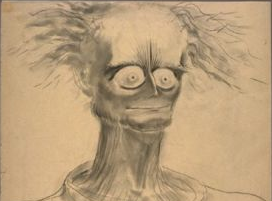
Other examples include the figure of 'Wrath' (left), by Schulze-Mittendorff, was one of the 'Death and the Seven Deadly Sins' costumes and sculptures used in Metropolis, and the concept sketch for the character of 'Dr. Mabuse' (right), both featured eyeball aspects that are characteristic of the Maschinenmensch. The pupil misalignment in the case of 'Wrath', and it's exaggerated and raised iris region in the case of 'Dr.Mabuse' are evident. So thoroughly consumed by their emotions, these characters can be regarded as 'seeing blindly'.
Bertina Schulze-Mittendorff, daughter of Walter, provides her commentary on the expressions of the eyes captured in her father's works:
"This ‘calm madness’ is certainly caused by the eyes of 'Wrath' and 'Dr. Mabuse', but my father seems to be a master of causing effect by the look of eyes. In every eye pair one can sense a slightly different expression. Only Wrath’s eyes show pupils, all the other 7 figures don’t. This might be because anger, rage and fury are the most extroverted emotions; they each are cast out by the other. The eyes play an important role in this explosiveness.
In the eyes of the other deadly sins, including 'Death', you can sense a complete emptiness in the expression of the eyes. This underlines the purpose of those guises: they are masks of feelings which built up the unique character of what here is called 'sin'. They live only through their surface, inside they are empty in the sense of being not existent, without liveliness and substance.
This feels completely different in viewing the Maschinenmensch. Its stern look shows a hidden liveliness, there is a calmness inside which indicates that some higher spirit is dwelling there, a being with a much greater competence and consciousness as one is used to seeing in most real human faces. It looks enraptured but highly present. No madness penetrates through the eyes but only a silent awareness. Only its outside witness that death is the fate: it is a cold and rigid cocoon, a hull, a costume: transient. I would say the Maschinenmensch in its expression shows exactly the opposite of death and seven deadly sins and this difference is provoked even by the same artistic means. This is what art is about. "
Body sculpture
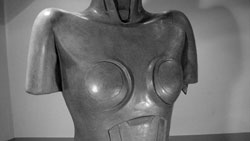
Wikipedia describes 'Expressionism' as a cultural movement, initially in poetry and painting, which originated in Germany at the start of the 20th century. Its typical trait was to present the world under an utterly subjective perspective, distorting it to obtain an emotional effect and to vividly transmit personal moods and ideas. Expressionist artists sought to convey the meaning of "being alive" as an emotional experience rather than a physical reality.
At the height of this movement, Schulze-Mittendorff had the opportunity to bring an expressionistic piece to the world in the powerful new media of film. It was an underestimated achievement. Like many things that have been so influential, and brought into being by humble individuals, with no delusions of grandeur, Schulze-Mittendorff modestly carried out this work. He simply 'did it' in his words (albeit in German). His work is proliferated in so many ways today. With frequent homages to his design in film, we realize how influencial his works have become in modern film and beyond.
The conceptualization of the first mechanical human being was a task befitting a visionary mind. In 1925, Schulze-Mittendorff may have been influenced by exciting and mystical world events, a profound one being in 1922, when the archeological discovery of the Pharaoh Tutankhamun's tomb in Egypt was discovered.
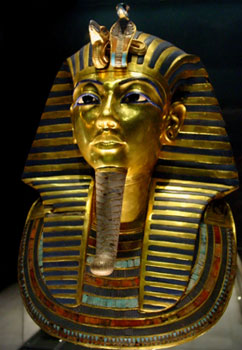
The original Tutankhamun burial mask
The 'hemes' head dress, cobra peak, eye make-up, and beard forms culminate in an unmistakable similarity to the Maschinenmensch design. Even the solid blocking of ear forms on the head dress are emulated in the robot. Aside from the natural human traits, there are many shapes in the piece that are matched in the robot body. Like many of Schulze-Mittendorff's works, he has drawn inspiration from historical spiritual symbols and sculptural artefacts. The highly polished gold facial features of Tutankhamun's burial mask obviously struck a chord with him when he was asked by director Fritz Lang to imagine the appearance of a metal mechanical man.
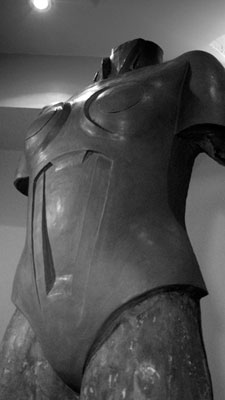
What would an imitation human being look like if she were built by hand?
Schulze-Mittendorff indicated that he had no issues with coming up with a design. He asserted simply that "Expressionism was alive", and therein he had conjured his direction. With his design established, his priority turned to find a suitable material for its creation. At first he had considered using real metal in the form of an embossed copper sheet, but it was assessed that this would be too cumbersome and awkward to wear. A material that could simulate metal was sought, and while visiting an architectural model shop for another purpose, he found a small cardboard box that had been mailed to the shop labelled "Plastic Wood -sample without value", and as it was of no interest to them, the sample was placed at Schulze-Mittendorff's disposal. A working specimen of the material provided instant proof that this was to be the substance that would be used as the basis for the Maschinenmensch. This plastic wood turned out to be a pliable wooden material that was fast hardening on exposure to air. Once dried, it could be worked on and treated like naturally grown wood. Strips of muslin cloth were covered with this plastic wood and rolled out with a kitchen rolling pin to an approximately 2 millimeter thickness. The fibre reinforced material was then stretched over the plaster copy of Brigitte Helm's body form like a shoemaker would stretch leather over a buck form. When the material was dried and hardened the raw parts could be ground, and the contours cut into the armoured plates. The next step in the process was to provide technical aesthetics for the armour by assigning and fitting in surface details to enhance its appearance. When the model forms were finished, the final stage was to paint the suit with a cello lacquer that had been mixed with "Silberbronze" (an alloy of copper and silver) and shot through a spray gun for a uniform coating. A polished " Weißmetall" (white metal alloy) appearance had been achieved. The context of Fritz Lang's 'Metropolis' film was so ground breaking and grandios in scale, that it warranted these extra efforts that would lead to a flawless looking production, and that would withstand the test of time, now very nearly 100 years later.
TO BE CONTINUED...
Official Metropolis Robot Merchandise PAGE HERE
"The influence of the Metropolis female android cannot be overstated. Building on important design ideas from the Russian Constructivists and the Futurism movement, it presaged a future of film art that was still decades away. AND it gave us C3pO!"
-Adam Savage, Television Personality: Mythbusters
